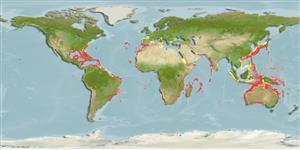Elasmobranchii (sharks and rays) >
Hexanchiformes (Frill and cow sharks) >
Hexanchidae (Cow sharks)
Etymology: Hexanchus: Greek, exa = six + Gree, agcho, narrow (Ref. 45335); nakamurai: Named for Dr. Hiroshi Nakamura.
Environment / Climate / Range
Ecology
Marine; bathydemersal; depth range 0 - 600 m (Ref. 5578), usually 90 - 600 m (Ref. 6874). Deep-water, preferred ?; 49°N - 35°S, 99°W - 161°E (Ref. 55216)
Wide-ranging, patchily distributed species, in warm temperate and tropical seas (Ref. 94780). Western Central Atlantic: Mexico (Ref. 13186), off Bahamas, northern Cuba, Nicaragua and Costa Rica. Eastern Atlantic: France to Morocco, including Mediterranean Sea (Ref. 13573); possibly Côte d'Ivoire and Nigeria. Indian Ocean: off eastern and southern Africa (Ref. 13573), Aldabra Island (India); Western Australia (Ref. 6871). Western Pacific: Japan, Taiwan, Philippines, New Caledonia and eastern Australia (Ref. 13573).
Length at first maturity / Size / Weight / Age
Maturity: Lm ?, range 142 - 178 cm
Max length : 180 cm TL male/unsexed; (Ref. 247); common length : 120 cm TL male/unsexed; (Ref. 5217)
Vertebrae: 155. This slender-bodied shark is readily distinguished from its larger congener (H. griseus) by having a narrower head, relatively larger eyes, 5 large lower comb-shaped anterolateral teeth, a long slender dorsal-caudal space, with distance from the dorsal origin to the upper caudal origin being at least twice the length of the dorsal fin base; with the upper and lower caudal postventral margins forming a strong arch. In life, Color of dorsum a uniform pale brown without a light line extending along the lateral body trunk, the trailing fin edges are white in some specimens and the ventral surface is lighter (Ref. 94780).
Found on continental and insular shelves and upper slopes, from 90 to 600 m depth, usually on or near bottom, may move to the surface at night (Ref. 247, 5578). Probably feeds on bony fish and crustaceans (Ref. 13573). Ovoviviparous (Ref. 205), with 13 young in a litter (Ref. 247). Size at birth measures to about 40-43 cm TL (Ref. 94780). Not dangerous to people as far as is known (Ref. 247). Utilized for its fins, meat and liver oil but of little value due to its relatively small size (Ref.58048).
Ovoviviparous, with number of young 13 in one litter. Length at birth about 43 cm (Ref. 247). Distinct pairing with embrace (Ref. 205).
Ebert, D.A., W.T. White and H.-H. Ho, 2013. Redescription of Hexanchus nakamurai Teng 1962, (Chondrichthyes: Hexanchiformes: Hexanchidae), with designation of a neotype. Zootaxa 3752(1):020-034. (Ref. 94780)
IUCN Red List Status (Ref. 115185)
CITES (Ref. 94142)
Not Evaluated
Human uses
Fisheries: subsistence fisheries
More information
ReferencesAquacultureAquaculture profileStrainsGeneticsAllele frequenciesHeritabilityDiseasesProcessingMass conversion
Tools
Special reports
Download XML
Internet sources
